When looking for product suppliers or service providers, it is a good business practice to have options from which you can select a preferred vendor. A request for a quote gives businesses opportunities to assess different vendors without tying them to a specific vendor. It is one of the first documents used in contracting a supplier. It is a document issued by companies to various vendors requesting them to provide quotes for prices of goods or services.
Companies usually issue it with specific and standard product requirements and may be sent independently or with a request for proposal. They contain technical requirements, terms of service, product specifications, and timelines for response to it. In response, vendors are supposed to provide their prices and preferred payment terms.
Alternative name
They are sometimes called invitations for bids (IFB), depending on their use and the maker’s preference.
Special Considerations
It is only an invitation to the vendors to state their prices; as such, no contractual relationship arises once a vendor responds. The contract only begins when the company sends a purchase order to the selected vendor. RFQs have their advantages and disadvantages; on one end, they limit the vendors to those preferred by the soliciting company; this allows the companies to select from their preferred vendors. In contrast, it may prevent the company from discovering better vendors with better prices because they will not receive the request.
When is It Used?
A soliciting company may request quotes from specific vendors when seeking particular products. The request is used when a company has specific vendors in mind because it is a direct request, not just an invitation to the public. It can also be used when the soliciting company requires specific products with specific standards. Since the company already has these specifications, the main factor for selection will be the price. The vendors are not invited to negotiate; instead, they are expected to name their prices.
RFQs are used when the product is procured repeatedly. The company may compile a list of vendors once they respond and send purchase orders to them once the need for the product arises or select a vendor to supply the product more than once.
Types of Such Bid
A company may issue different requests depending on the type and nature of products and services required. They include:
Open bid
Open bidding occurs when a bid allowing any qualified vendor to respond is issued. In an open bid, any vendor may respond to the bid as long as they qualify to provide the product or service sought. Open bids promote competition among vendors because they have pricing visibility, which may cause vendors to fix their prices, ultimately causing the company to lose out on good vendors.
Sealed bid
A sealed bid is when vendors submit their offers in response in sealed envelopes. The envelopes are then published on a predetermined date, and the vendors can watch as the best bid is selected. Sealed bidding is one of the most transparent methods of tendering. However, vendors may not be motivated to give their best prices because it lacks open pricing.
Invited bid
In an invited bid, pre-selected vendors respond directly to a bid issued. This bid saves time because the soliciting company only sends requests to vendors it has vetted. The number of expected responses is also predetermined. Because of its limited nature, this type of bid allows companies to use vendors they have contracted. While limiting the number of vendors is beneficial, it may also cause the company to lose out on better vendors outside the company’s preferred vendors.
Reverse auction bid
The company requests the vendors to give their lowest quote in a reverse auction bid. The vendors compete to see who can offer the lowest price, unlike in an ordinary auction. The vendor with the lowest price automatically wins the bid. The reverse auction is quick and automatic, saving time that would otherwise be used to assess the vendors. However, because it is an automatic process, the company cannot assess other essential aspects of the bid. This may cause challenges where the company has to consider factors other than price.
RFQ V/s RFP V/s RFI
A request for a quote is one among other documents that may serve a similar purpose. The other documents used by companies to find vendors include requests for proposals and requests for information.
It differ from RFPs and RFIs in the following ways:
RFQ v/s RFP
A request for a quote requires vendors to state their prices in response to a product or service request. In it, the request can be issued at any stage in a project to request a product. In contrast, a request for a proposal provides information on a project and invites bidders to send bids on how they would complete the project. It is often issued at the beginning of a project.
The RFP provides detailed information on the project, including timelines, expected deliverables, and project scope and goal. The distinguishing factor is that they are mainly based on the price provided by the vendor, while RFPs factor in experience, reputation, and quality to select a vendor.
RFQ v/s RFI
A request for information is more exploratory. The soliciting company may not have a clear idea of the kind of response they want. Vendors respond by describing the different approaches they would use to solve the issue posed in the RFI. The best bid is usually selected based on the best response. In contrast, a request for a quote is on a decided product with selected standards, and the vendor is chosen based on the price quoted.
NOTE
A request for quote typically discusses the price for the products, so before sending an RFQ, most companies issue a statement of work stating the details of a project to establish an understanding between themselves and the contractors. The work statement contains a scope describing the project’s tasks in detail. After establishing the type of work to be done, it is sent to determine the contract’s price.
Free Templates: Request for Quote
It is a detail-oriented and product-specific document; you may find it time-consuming to make it from scratch. Instead, when in doubt, you can use a template. Templates provide a guideline for creating an effective request for quote without the hassle of researching what information you need to include.
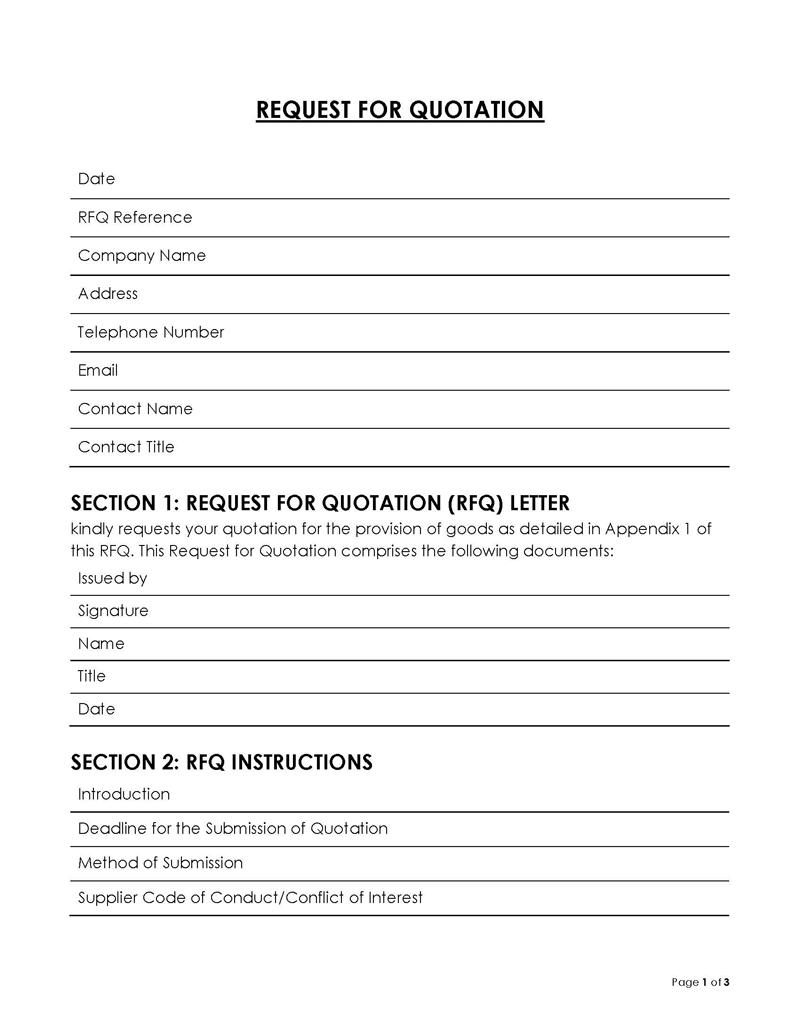
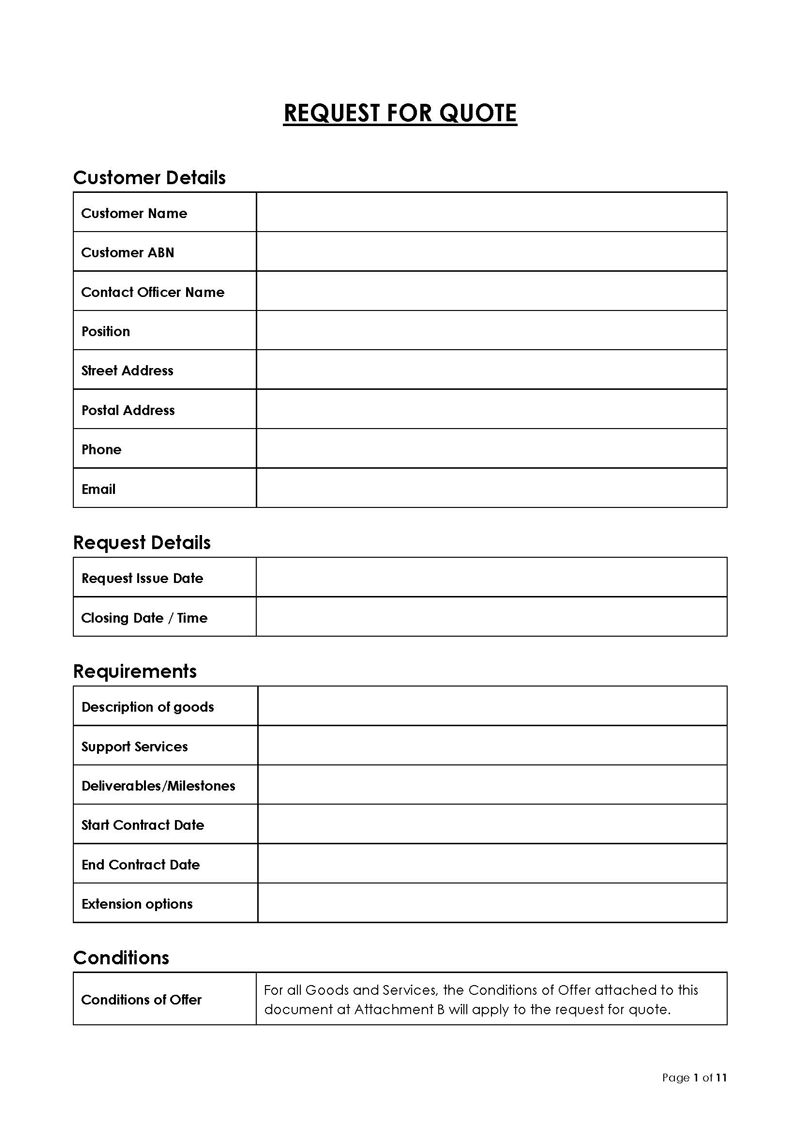
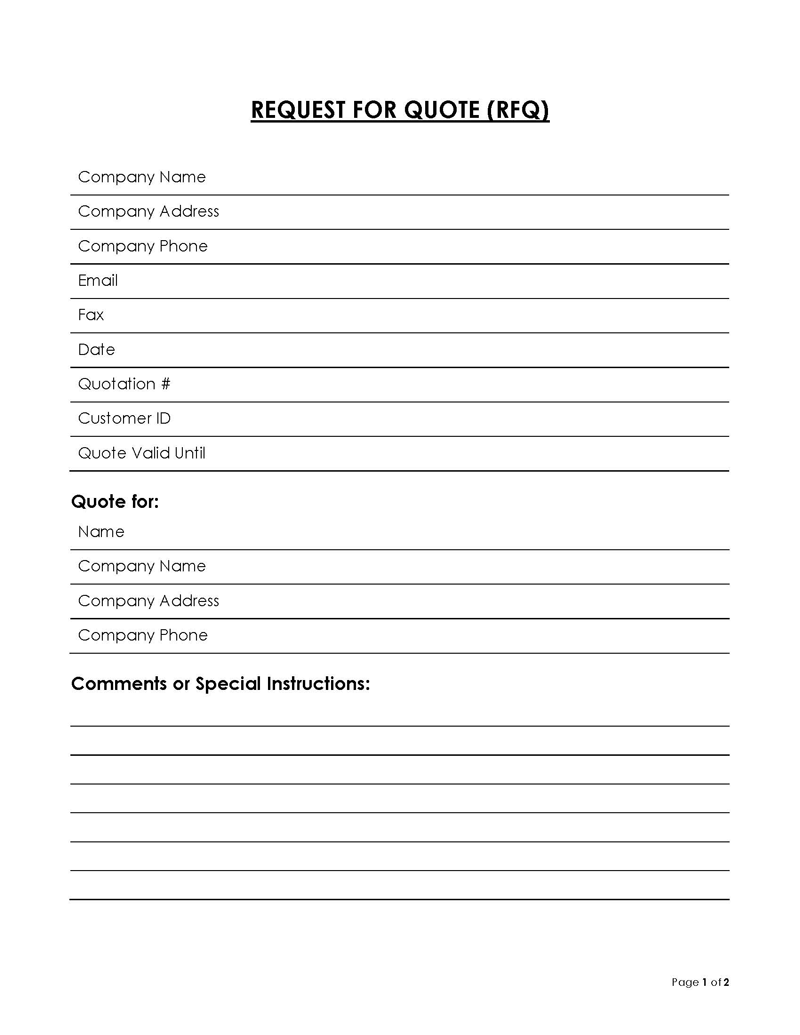
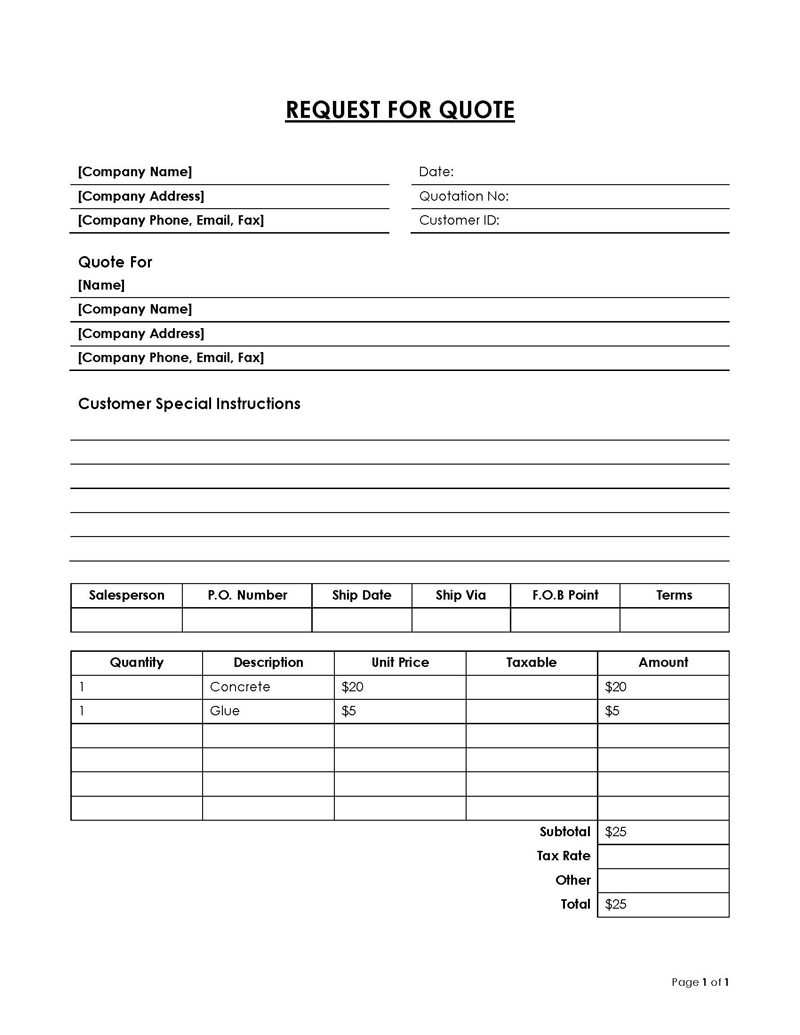
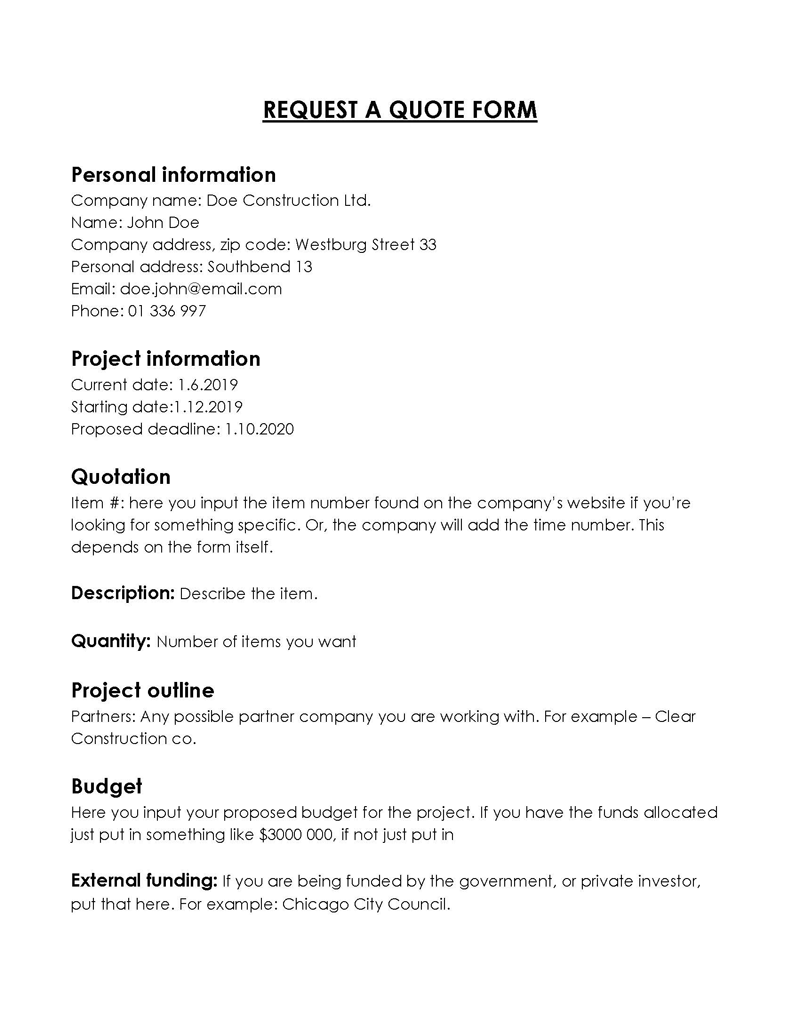
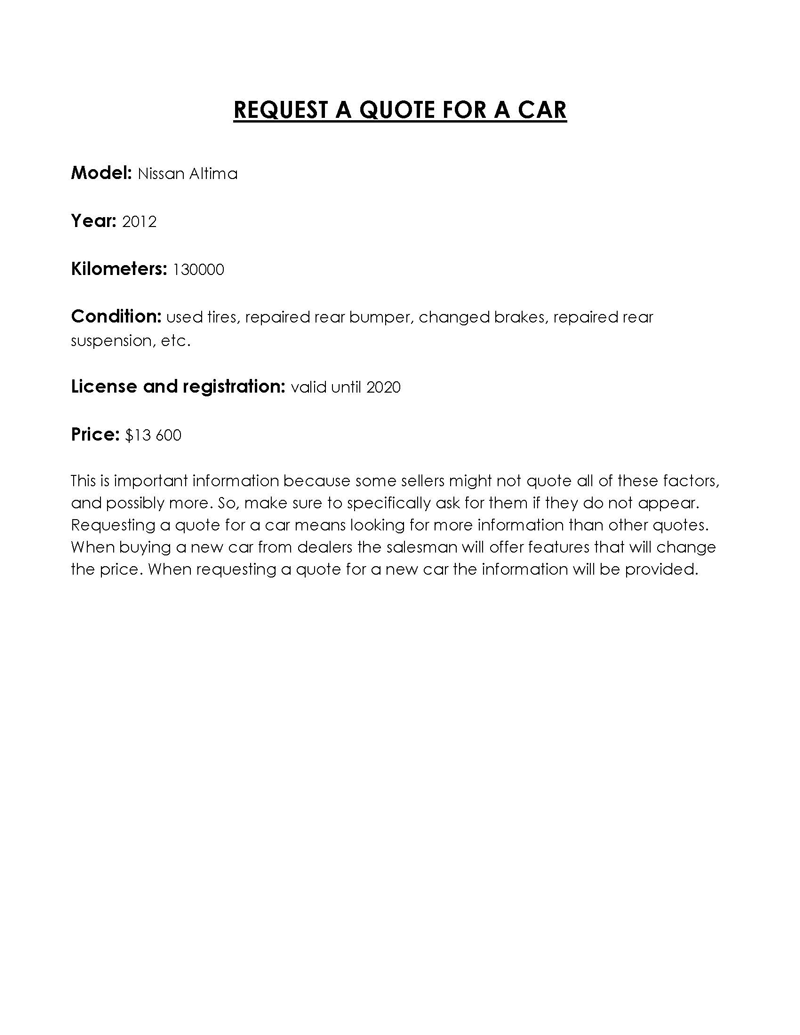
What is Included in an RFQ?
It requires a response on the price of a service or product; it is, therefore, crucial to provide instructions on how the vendor should respond. You should provide crucial information on the company and the products to the vendor so they can tailor the response to your needs.
You should include the following information:
Buyer’s information
- The name of the project
- The objectives and a brief statement of the problem
- The buyer’s contact person information
- Details on how bidders should respond
- Deadlines for the activities
Detailed specification
- Description of the product/service
- Required quantities
- Acceptable product standards
- Terms of delivery
- Criteria for pricing
Selection criteria
- Type of bid (Open/closed)
- Prequalification questionnaire
- Criteria for grading
- Deadlines for selection
Terms and conditions
- Terms and conditions
- Legal qualifications
- Disclosures
- Contract
How Do These Processes Work?
The company should approve a request for quotes internally before sending them out to potential vendors. It must comply with internal standards because the sourced product or service will contribute to the business.
The request for quote process is as follows:
Selecting the type
The type of request you select depends on the bulk and variety of products you want to be supplied. Based on the products, there are:
- Standard RFQs: It is used when ordering a particular product in a specific amount. They are also used for products that are not used constantly.
- Catalog RFQs: It is used when making an order for a product that is procured continuously
- Bid RFQs: These Bids are typically used to order machinery or equipment.
Preparing the document
Once you have selected the type, you should prepare the document. It should contain the product you want to order, the kind of RFQ bid (open or sealed), the vendors to which it will be issued, and the timelines for submission. Remember to prepare it simply so that you can compare the prices.
Collecting the relevant documents
The request must include documents providing relevant information to the potential vendors. The documents will help vendors understand the requirements and help them to craft a proper response.
They include:
- An invitation to bid, which describes the quotations required.
- Terms and conditions, which outline the legal framework for the request.
- A pricing table is attached to it. It provides guidelines for vendors and helps the company compare the prices.
- Statement of the timelines for submission and selection of vendors.
- A prequalification questionnaire, which vendors will fill out to evaluate whether they are qualified to participate in the bidding process.
- A statement on the selection and evaluation criteria will be used to choose the successful vendor.
Deciding on a selection criterion
The selection criteria should be fair and reasonable to encourage vendors to respond to your request. A good selection criterion is based on common aspects like product quality, cost of products, a balance between price and quality, and a good return on the money invested in the project.
Issuing and management
Once the request is ready, you can send it to the selected vendors. It is recommended that companies issue it to at least three and at most eight vendors. Sending the request to too many vendors might be time-consuming in sending, receiving, and comparing the responses. And issuing a few might result in excluding better vendors.
Closing and contracting
After receiving all the responses and after the set deadline has passed, you should select the vendor with the best quote and begin negotiations. The review committee may choose a vendor based on the selection criteria, after which the final contract should be signed. Finally, issue appreciation letters to the other vendors to inform them that the process is complete and thank them for their participation.
Review and evaluation
After selecting the vendor, reviewing and assessing the signed contract is essential. Companies can use the request issued to determine whether the vendor is performing as expected.
You can use the questions below as a guide when reviewing:
- Has the vendor fulfilled its obligations?
- Is the service or product of acceptable standards?
- Is there a better offer in the market?
- Is the vendor working within the set timelines?
Advantages and Disadvantages
It can be beneficial and non-beneficial to the soliciting companies and potential vendors. They are preferred because soliciting companies select from the many vendors they are interested in and can limit the number of requests. Consequently, they can save on time spent selecting the successful vendor because they know the number of responses to expect.
On the other hand, requests for quotes may limit the number of vendors, which may cause the company to miss an opportunity to get better offers. Further, because the list is limited, there is less competition among vendors, which may affect the quality of products. Issuance of RFQs may also be subject to abuse because the companies may favor their preferred vendors when selecting their prequalification criteria.
Frequently Asked Questions
A request for quotation is used by companies that already know what product they want and are only looking for the best market price. An RFQ helps companies acquire products for the best price.
A simple RFQ contains the company details, the RFQ reference number, the quotation, the terms and conditions, payment and delivery details, and a quotation footer with the authorization for issuance of the RFQ.
The RFQ, RFI, and RFP are all requests for information in different capacities. The RFI is more general, while the RFQ and RFP request more specific information like pricing and delivering capacity.
RFQs cater to specific needs and may not be ideal for every situation. They are preferred where you have determined the product and the amount of product you want. You should also research and list vendors that fit your qualifications and use price as the critical factor in selecting a vendor.









